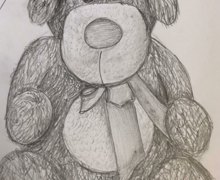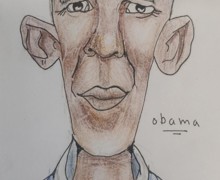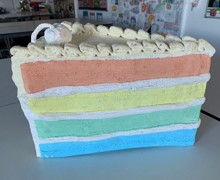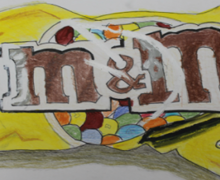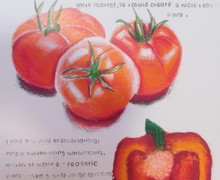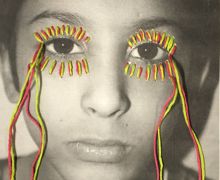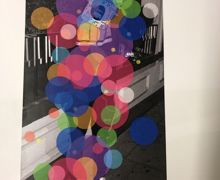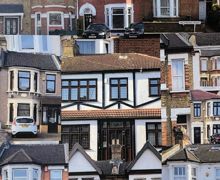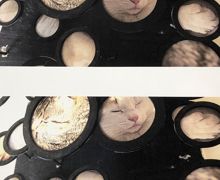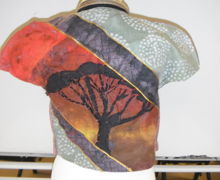- Home
- Secondary
- Subject Information
Art, Photography, and Textiles
BackIntroduction
In the Art department, our principle aim is to develop the students’ knowledge, skills and understanding of Art, Photography and Textiles. We ensure that the act of investigating and making something includes exploring and developing ideas, and evaluating and developing work. Our curriculum sets out to engage, inspire and challenge pupils, equipping them with the knowledge and skills to experiment, invent and create their own works of art.
The Art, Photography and Textiles departments are located on the third floor at the southern end of the school. They consist of 4 well-equipped classrooms which are all-inclusive of an interactive whiteboard, as well as a photographic darkroom, and a pottery kiln. The department also has unlimited access to a range of laptops for use in all classrooms. Being on the third floor means that the rooms are flooded with daylight, and have panoramic views across the rooftops towards the City of London and Docklands.
The rooms are located around a gallery display area where student work can be seen. Displays are rotated regularly displaying the work of Key Stage 5 Art and Photography students. At the end of each year, Art and Photography hold an exhibition in the main hall to celebrate a student’s achievements and creative abilities. Students are proud to have the opportunity of inviting their teachers, friends and family to attend a private view of the work.
The department offers after school clubs on most weekdays as well as providing open rooms for students to develop their work independently most lunchtimes and during free periods.
Our expectations:
Within the Loxford Art dept. you will be immersed in a world of art with dedicated displays on the classroom walls and corridors.
We challenge the student to be inventive, creative and inspired to maintain our high standards. Homework of the month is proudly displayed in the School. We encourage the student to be proactive in completing coursework assignments inside and outside of the classroom.
KS3
Whilst students may have studied some aspects of this subject in their primary school, this will be their first experience of a regular timetabled slot for Art and Design. It is an exciting subject where students have the opportunity to develop their ideas in a wide range of media and to use high-quality facilities. We have a well-equipped Art department with experienced specialist teachers who will bring their love of the subject into each lesson. They are specialists in Painting, Sculpture, Textiles, Art History, Printmaking, Photography and Illustration.
What work is involved in Key Stage 3?
Students will be given a sketchbook to record their work and ideas in school. Over the three years, students will have 1 hour of art lessons a week. They will explore a range of different media and will study different artists and movements to help influence and inspire their work.
Year 7
In year 7, students will work on a diverse range of projects that are linked to developing key skills. We work to extend understanding of drawing, mixed media, painting, printing and sculpture. Students will be encouraged to research artists varying in style and periods. Students will learn to understand why and how the art was made, as well as develop an informed knowledge of different periods, styles and techniques. Students will then respond to artists’ artworks using appropriate techniques and will be helped to plan and develop their ideas. Each student will develop exciting and individual outcomes.
Additionally, they will be inspired by the art carried out by students at Loxford School, which you can see displayed on the corridors and within the department. We are always a busy department as many students spend their lunchtimes in the department working on ideas or improving their homework.
Projects taught: Key skills, Fauvism, 3D letters, Insects, Hundertwasser landscape, Paper sculpture.
| Homework Project | Key Skills | 3D Letters | Fantasy Creatures | Hundertwasser |
|---|
Year 8
In year 8, students will work on a range of projects that will enable them to create cross curricular and cultural links. The students will extend their understanding of drawing, mixed media, painting, printing and sculpture. Students continue to research and respond to artists’ artworks using appropriate techniques and will be helped to plan and develop their ideas. Each student will develop exciting and individual outcomes.
Additionally, they will be inspired by the art carried out by students at Loxford School, which you can see displayed on the corridors and within the department as well as at the end of year exhibition. We are always a busy department as many students spend their lunchtimes in the department working on ideas or improving their homework.
Projects taught: Expressionist Portraits, Ugly Clay Mugs, Constructivism, Identity Vessels, Natural forms, Paper Sculptures.
| Homework Project | Expressionist Portraits | Caricatures | Comic Art | Natural Forms |
|---|---|---|---|---|
| Constructivism |
Year 9
In year 9, students will work on a range of exciting topics linked to their identity. They extend and consolidate their understanding of drawing, mixed media, painting, printing and sculpture. Students are encouraged to research and to respond to artists’ artworks with more creativity and detail, as well as form their own opinions. Students are given every opportunity to refine their skills should they wish to take a GCSE in Art.
Additionally, they will be inspired by the art carried out by students at Loxford School, which you can see displayed on the corridors and within the department as well as at the end of year exhibition. We are always a busy department as many students spend their lunchtimes in the department working on ideas or improving their homework.
Projects taught: Pop Art Junk Food, Printing, Sweets, GCSE Unit.
| Homework Project | Pop Art | Junk FoodPop Art Portraits | GCSE Unit | Paper Sculpture |
|---|
KS4
Why you should consider this subject
- Exam Board: AQA
- Coursework – 60%
- Exam – 40%
Art and Design SpecificationArt and design is the main subject for students looking to develop their creativity and understanding through a visual language. Many companies, business and institutions value the skills developed on an Art and design course as students will be extremely self-motivated, industrious, creative and talented individuals. There are also a wide range of careers that involve the sort of visual awareness that an Art GCSE will develop. Art at it most fundamental level develops your understanding of the world through enquiry and observation. Responding creatively to your environment is a way of learning more about yourself and other people. It is, therefore, a subject which is worth studying for its own intrinsic value.
Art
Year 10
Natural and Mechanical Forms
Students will develop a response to the theme, ‘Natural and Mechanical Forms’, evidencing the journey from their initial engagement with an idea to the realisation of an outcome. This will give students the opportunity to demonstrate, through an extended creative response, their ability to use a range of media such as; biro, clay, pencil, paint and print.
Colour, Pattern and Texture
Students will develop a response to the theme, ‘Colour’, evidencing the journey from initial engagement with an idea to the realisation of an outcome. This will give students the opportunity to demonstrate, through an extended creative response, their ability to use a range of media such as; biro, clay, pencil, paint and print.
Year 11
Fragments
Students will develop a response to the theme, ‘Fragments’, evidencing the journey from initial engagement with an idea to the realisation of an outcome. This will give students the opportunity to demonstrate, through an extended creative response, their ability to use a range of media such as; biro, clay, paint, pencil and print.
Exam Unit
Students will have the opportunity to choose their theme and artist, with the support of their teacher. Students will then develop their ideas by evidencing the journey from initial engagement with an idea to the realisation of an outcome. This will give students the opportunity to demonstrate, through an extended creative response, their ability to use a range of media such as; biro, clay, paint, pencil and print.
Photography
Year 10
Natural and Mechanical Forms
Students will develop a response to the theme, ‘Natural and Mechanical Forms’, evidencing the journey from their initial engagement with an idea to the realisation of an outcome. Students will be introduced to a variety of experiences that explore a range of photographic media, techniques and processes such as; process film, enlarge prints, the use of chemicals and enlargers in the dark room, light box, studio shoot and editing software.
Colour, Pattern and Texture
Students will develop a response to the theme, ‘Colour’, evidencing the journey from initial engagement with an idea to the realisation of an outcome. Students will apply different techniques such as light painting, hand colouring, colour replacement, pencil and brush tool. Students will also learn how to use mixed media approaches such as sewing and photomontage in response to the artists that they are studying.
Year 11
Fragments
Students will develop a response to the theme, ‘Fragments’, evidencing the journey from initial engagement with an idea to the realisation of an outcome. This will give students the opportunity to demonstrate, through an extended creative response, their ability to use a range of different digital techniques.
Exam Unit
Students will have the opportunity to choose their theme and artist, with the support of their teacher. Students will then develop their ideas by evidencing the journey from initial engagement with an idea to the realisation of an outcome. This will give students the opportunity to demonstrate, through an extended creative response, their ability to the range of techniques.
Textiles
Year 10
Natural and Mechanical Forms
Students will develop a response to the theme, ‘Natural and Mechanical Forms’, evidencing the journey from their initial engagement with an idea to the realisation of an outcome. Students will learn to demonstrate skills such as; mixed-media, sewing machine stitches, applique, reverse applique, hand embroidery, poly tile printing and tie dye. When skills are obtained, students will develop and apply their knowledge, understanding and skills to constructing their wall hanging outcome.
Colour, Pattern and Texture
Students will develop a response to the theme, ‘Colour’, evidencing the journey from their initial engagement with an idea to the realisation of an outcome. Students will learn to demonstrate skills such as; weaving and batik. When skills are obtained, students will develop and apply their knowledge, understanding and skills to constructing their bag outcome.
Year 11
Fragments
Students will learn to demonstrate skills such as; shard applique, twisted applique, foliage applique, flat basket weaving, wavy stitch, cut, slash and burn. When skills are obtained, students will develop and apply their knowledge, understanding and skills to constructing their chosen outcome which may include; a pillow case or a skirt.
Exam Unit
Students will have the opportunity to choose their theme and artist, with the support of their teacher. Students will then develop their ideas by evidencing the journey from initial engagement with an idea to the realisation of an outcome. This will give students the opportunity to demonstrate, through an extended creative response, their ability to use a range of techniques.
GCSE Results 2023
Congratulations to the Year 11 students on achieving
96% grades 9-4 in Art
100% grades 9-4 in Textiles
100% grades 9-4 in Photography
GCSE Results 2022
Congratulations to the Year 11 students on achieving
93% grades 9-4 in Art
93% grades 9-4 in Textiles,
80% grades 9-4 in Photography
How will my child’s work be assessed?
Students will complete and be assessed on coursework that has been documented in sketchpads and out of sketchpad. Course work is based on the three themes above. This is worth 60% of the final grade. You will then work on the externally set assignment. The preparation period consists of approx 20hrs before a 10 hour Controlled Test under exam conditions. This is worth 40% of the marks.
Future Careers
What Sixth Form options does this course lend itself to?
Art and Design is a valued qualification by Universities and will support applications for a wide range of courses. Some students wish to pursue careers which are directly related to a study of Art and Design – Fashion, Textiles, Interior Design, Theatre Design, Ceramics, Fine Art-painting and sculpture, Graphics and Illustration and Architecture. Other students, whether Arts or Science-based, use Art & Design as an additional subject for University entry.
Extra Curricular
The Art Department conduct gallery visits and field trips for Year 10 and 11 art students. The students get the opportunity to view artwork first-hand gaining inspiration to interpret the artist’s style and techniques. We encourage students to follow up on their interests in Art and Design by visiting galleries. We also support some students with artist-led workshops. Students are encouraged to work on their ideas in lunchtime or after school.
Every student is invited to visit Kew Gardens as part of their first coursework project, and also to the British Museum as part of the second project in year 10. All students are taken to a Gallery visit as part of their examination unit in year 11. Some Gallerys we have visited include the Victoria and Albert Museum, Photographers Gallery and the Tate Gallery.
Useful Links
KS3
Tate ModernTate Modern, ArtistsVincent Van GoghHundertwasser
KS4
British MuseumNational Portrait GalleryWhite Chapel GalleryVictoria and Albert Museum (V&A)
Development of Ideas
Future careers for art:
By studying art based subjects students find out more about different forms of art including photography, fibre art and sculpture as well as traditional drawing, painting, printing and mixed media techniques.
It helps them learn how to appreciate different forms of art as well learn how art has changed over time.
Art and Design is a valued qualification by Universities and will support applications for a wide range of courses.
Some students wish to pursue careers which are directly related to a study of Art and Design – Fashion, Textiles, Interior Design, Theatre Design, Ceramics, Fine Art-painting and sculpture, Graphics and Illustration and Architecture. Other students, whether Arts or Science-based, use Art & Design as an additional subject for University entry.



